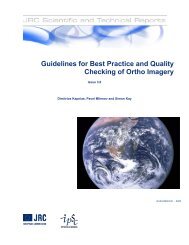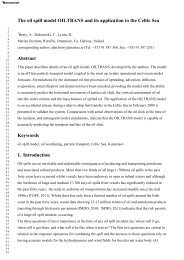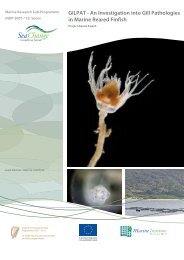Marine Industries Global Market Analysis - Marine Institute
Marine Industries Global Market Analysis - Marine Institute
Marine Industries Global Market Analysis - Marine Institute
Create successful ePaper yourself
Turn your PDF publications into a flip-book with our unique Google optimized e-Paper software.
86 MARINE INDUSTRIES GLOBAL MARKET ANALYSIS<br />
14.3 EUROPEAN MARKET<br />
<strong>Marine</strong> aquaculture production in Western Europe (€3.5 billion in 2004) is ranked<br />
second to Asia in regional production value (€17 billion), but this only amounts to a<br />
fifth of Asia’s. According to available data, Eastern Europe’s production is very small<br />
compared to Western Europe. As within the capture fisheries, Norway is the European<br />
leader by far with its production equal to the combined production of the UK,<br />
France and Spain. European production values are forecast to increase, in-line with<br />
global estimates, at a rate of 4% per annum from 2005 to 2009.<br />
Total European (EU25) production grew by more than 40%, from 1 million tonnes in<br />
1993 to 1.4 million in 1999, and then declined very slightly. 56 France, Italy, Norway,<br />
Spain and the UK are the largest players. Norwegian production at 554,000 tonnes in<br />
2002 is nearly twice that of its nearest rival Spain. (By comparison, Japan produces<br />
about 1.3 million tonnes.)<br />
Within Ireland a number of factors led to a decrease in salmon production from<br />
21,423 tonnes in 2002 to 16,437 tonnes in 2003 (although trout farming was<br />
unaffected).This was due to company receiverships, market issues, disease and other<br />
unfavourable environmental factors. In addition, other countries are able to market<br />
the same products at reduced prices. Price battles among retailers are also contributing<br />
to the pressure to keep prices low – a situation that benefits consumers, whilst<br />
damaging suppliers.<br />
14.4 CHALLENGES<br />
The reputation of farmed fish suffered with the publishing of a report in ‘science’ in<br />
2004, on the levels of chemicals within the fish.The effect of the article highlights<br />
how vulnerable the industry is to negative press. (There has been good development<br />
of Irish mussels since the bio-toxin issue was resolved.) Aquaculturists’ freedom to<br />
improve fish is limited by the need to consider the effects of new or modified fish on<br />
the aquatic ecosystem and human health.The industry has to become more united<br />
and sophisticated in its approach to marketing and promoting the sustainability and<br />
health benefits of farmed seafood. 57<br />
It is thought that the US and Europe will continue to experience increased imports<br />
from Asia.The challenge for exporters is to ensure that they supply safe, properly<br />
labeled products.<br />
56<br />
‘Eurostat Yearbook’ 2004<br />
57<br />
‘Intrafish’, December 2004, p15

















